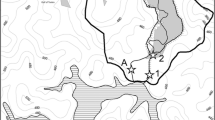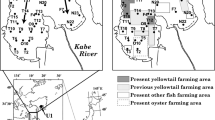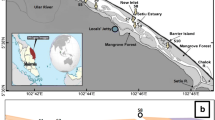Abstract
This study compares nutrient and sediment retention among rice and fish farms and wetlands in valley bottoms in southern Rwanda. Small-scale wetland, rice and fishpond experimental systems were established to measure sediment, nitrogen (N) and phosphorus (P) fluxes during a 9-month period. There were significant differences in the processes contributing to sediment, N and P retention in the three systems related to system characteristics, management practices, and seasons. Overall nutrient retention was higher in the rice and fish systems, but these systems had higher inputs and outputs of sediment and nutrients. In rice plots, resuspension and discharge of sediment and nutrients to the outflow were caused by ploughing and weeding during the first 3 months of the culture period. In fishponds, nutrients and sediment discharge were associated with water renewal and sediment removal during the last 5 months of the farming period. The undisturbed wetland plots had the lowest outflows of sediment and nutrients. Nutrient uptake and accumulation in biomass was much higher in rice and wetland vegetation than in fish biomass. In fishponds and wetlands, nutrients accumulated in soil, whereas rice plots showed a decrease or depletion in nutrient storage. To increase nutrient utilization at the plot level, sediment and nutrient discharge from land preparation and rice transplanting should be reduced by better farm practices. Within a catchment, nutrient flows can be integrated by using fishpond sediments for crop farming, by incorporating natural wetlands in crop rotations or using them as buffer zones.








Similar content being viewed by others
Data availability
The datasets generated for this study are available on request to the corresponding author.
Code availability (software application or custom code)
Not applicable.
References
Alldred M, Baines SB (2016) Effects of wetland plants on denitrification rates: a meta-analysis. Ecol Appl 26:676–685. https://doi.org/10.1890/14-1525
APHA (2005) Standard methods for the examination of water and wastewater, 21st edn. American Public Health Association, Washington DC
Avnimelech Y (1998) Minimal discharge from intensive fishponds. World Aquac 9:32–37
Bagalwa M (2006) The impact of land use on water quality of the Lwiro River, Democratic Republic of Congo, Central Africa. Afr J Aquat Sci 31:137–143. https://doi.org/10.2989/16085910609503881
Banas D, Masson G, Leglize L, Pihan JC (2002) Discharge of sediments, nitrogen (N) and phosphorus (P) during the emptying of extensive fishponds: effect of rain-fall and management practices. Hydrobiologia 472:29–38. https://doi.org/10.1023/A:1016360915185
Bolstad PV, Swank WT (1997) Cumulative impacts of land use on water quality in a southern Appalachian watershed. J Am Water Resour Assoc 33:519–533
Boyd CE, Tucker CS (1995) Sustainability of channel catfish farming. World Aquac 26:45–53
Boyd CE, Tucker CS (1998) Pond water quality management. Kluwer Academic Public, Nowell
Burt TP, Pinay G (2005) Linking hydrology and biogeochemistry in complex landscapes. Prog Phys Geogr 29:297–316. https://doi.org/10.1191/0309133305pp450ra
Davidson NC (2014) How much wetland the world has lost? Long-term and recent trends in global wetland area. Mar Freshw Res 65:934–941. https://doi.org/10.1071/MF14173
de Villiers S, Thiart C (2007) The nutrient status of South African rivers: concentrations, trends and fluxes from the 1970s to 2005. S Afr J Sci 103:343–349
Drexler JZ, Anderson FE, Snyder RL (2008) Evapotranspiration rates and crop coefficients for a restored marsh in the Sacramento-San Joaquin Delta, California, USA. Hydrol Process 22:725–735. https://doi.org/10.1002/hyp.6650
Emerson K, Russo RC, Lund RE, Thurston RV (1975) Aqueous ammonia equilibrium calculations: effect of pH and temperature. J Fish Res Board Can 32:2379–2383
Everitt BS, Hothorn T (2010) A handbook of statistical analyses using R, 2nd edn. CRC Press, Taylor and Francis Group, Boca Raton
FAO (1998) Crop evapotranspiration - guidelines for computing crop requirements. FAO Irrigation and Drainage Paper 56. Food and Agriculture Organization of the UN, Rome. www.fao.org/docrep/2014
Fillery IRP, Vleck PLG (1986) Reappraisal of the significance of ammonia volatilization as a N loss mechanism in flooded rice fields. Fert Res 9:79–98
Garcia JL, Tiedje JM (1982) Denitrification in rice soils. In: Microbiology of tropical soils and plant productivity. Springer, Dordrecht, pp 187–208
Hargreaves JA (1998) Nitrogen biogeochemistry of aquaculture ponds. Aquaculture 166:181–212. https://doi.org/10.1016/S0044-8486(98)00298-1
Hecky RE, Harvey A, Bootsma HA, Kingdon ML (2003) Impact of land use on sediment and nutrient yields to Lake Malawi/Nyasa (Africa). J Great Lakes Res 29:139–158. https://doi.org/10.1016/S0380-1330(03)70544-9
Henao J, Baanante C (1999) Estimating rates of nutrient depletion in soils of agriculture lands in Africa. International Fertilizer Development Center, Muscle Shoals
Hirsch RM (2012) Flux of nitrogen, phosphorus, and suspended sediment from the Susquehanna River Basin to the Chesapeake Bay during Tropical Storm Lee, September 2011, as an indicator of the effects of reservoir sedimentation on water quality. USGS Sci Investig Rep 2012–5185, p 17
Jiménez-Montealegre R, Verdegem M, Zamora JE, Verreth J (2002) Organic matter sedimentation and resuspension in tilapia (Oreochromis niloticus) ponds during a production cycle. Aquacult Eng 26:1–12. https://doi.org/10.1016/S0144-8609(01)00086-3
Kadlec RH, Wallace SD (2009) Treatment wetlands, 2nd edn. CRC Press, Boca Raton
Konnerup D, Trang NTD, Brix H (2011) Treatment of fishpond water by recirculating horizontal and vertical flow constructed wetlands in the tropics. Aquaculture 313:57–64. https://doi.org/10.1016/j.aquaculture.2010.12.026
Krupnik TJ, Six J, Ladha JK, Paine MJ, van Kessel C (2004) An assessment of fertilizer nitrogen recovery efficiency by grain crops. In: Mosier AR, Syers JK, Freney JR (eds) Agriculture and the nitrogen cycle. Assessing the impacts of fertilizer use on food production and the environment. SCOPE 65, Ch. 14. Island Press, Washington, pp 193–207
Kufel L (2012) Are fishponds really a trap for nutrients? A critical comment on some papers presenting such a view. J Water Land Dev 17:39–44. https://doi.org/10.2478/v10025-012-0005-0
Lenth R (2020) emmeans: estimated Marginal Means, aka Least-Squares Means. R package version 1.4.8. https://CRAN.R-project.org/package=emmeans
Lin CK, Yi Y (2003) Minimizing environmental impacts of freshwater aquaculture and reuse of pond effluents and mud. Aquaculture 226:57–68. https://doi.org/10.1016/S0044-8486(03)00467-8
Lohse KA, Brooks PD, McIntosh JC, Meixner T, Huxman TE (2009) Interactions between biogeochemistry and hydrologic systems. Annu Rev Env Resour 34:65–96. https://doi.org/10.1146/annurev.environ.33.031207.111141
McCartney M, Rebelo LM, Senaratna Sellamuttu S, de Silva S (2010) Wetlands, agriculture and poverty reduction. IWMI Res Rep 137. International Water Management Institute, Colombo, Sri Lanka
MEA (2005) Millennium Ecosystem Assessment (MEA). Ecosystems and Human Well-being: synthesis. Island Press, Washington
MINAGRI (2009) Strategic Plan for the Transformation of Agriculture in Rwanda—Phase II (PSTA II). Final report. Ministry of Agriculture and Animal Resources, Republic of Rwanda, p 114. http://www.https://www.gafspfund.org/
MINAGRI (2013) National rice development strategy (Period 2011–2018). Ministry of Agriculture and Animal Resources, Kigali, Rwanda. http://www.minagri.gov.rw
Muendo PN, Verdegem MC, Stoorvogel JJ, Milstein A, Gamal EN, Duc PM, Verreth JAJ (2014) Sediment accumulation in fish ponds; its potential for agricultural use. Int J Fish Aquat Stud 1:228–241
Munyaneza O, Wenninger J, Uhlenbrook S (2012) Identification of runoff generation processes using hydrometric and tracer methods in a meso-scale catchment in Rwanda. Hydrol Earth Syst Sci 16:1991–2004. https://doi.org/10.5194/hess-16-1991-2012
Namaalwa S, van Dam AA, Gettel GM, Kaggwa R, Zsuffa I, Irvine K (2020) The impact of wastewater discharge and agriculture on water quality and nutrient retention of Namatala wetland, Eastern Uganda. Front Environ Sci. https://doi.org/10.3389/fenvs.2020.00148
Nhan DK, Verdegem MCJ, Milstein A, Verreth JAV (2008) Water and nutrient budgets of ponds in integrated agriculture–aquaculture systems in the Mekong Delta, Vietnam. Aquac Res 39:1216–1228. https://doi.org/10.1111/j.1365-2109.2008.01986.x
Nhapi I, Wali UG, Uwonkunda BK, Nsengimana H, Banadda N, Kimwaga R (2011) Assessment of water pollution levels in the Nyabugogo Catchment, Rwanda. Open Environ Engn J 4:40–53. https://doi.org/10.2174/1874829501104010040
Piña-Ochoa E, Álvarez-Cobelas M (2006) Denitrification in aquatic environments: a cross-system analysis. Biogeochemistry 81:111–130. https://doi.org/10.1007/s10533-006-9033-7
Pinheiro J, Bates D, DebRoy S, Sarkar D, R Core Team (2017) nlme: linear and nonlinear mixed effects models. R package version 3.1–131.1, https://CRAN.R-project.org/package=nlme
Prein M (2002) Integration of aquaculture into crop–animal systems in Asia. Agric Syst 71:127–146. https://doi.org/10.1016/S0308-521X(01)00040-3
R Core Team (2016) R: a language and environment for statistical computing. R Foundation for Statistical Computing, Vienna
Ramsar Convention on Wetlands (2018) Global Wetland Outlook: State of the World’s Wetlands and their Services to People. Gland, Switzerland: Ramsar Convention Secretariat. https://www.global-wetland-outlook.ramsar.org/
Reddy KR, Delaune RD (2008) Biogeochemistry of wetlands: science and applications. CRC Press/Taylor and Francis Group, Boca Raton
Roger PA, Ladha JK (1992) Biological N2 fixation in wetland rice fields: estimation and contribution to nitrogen balance. Plant Soil 141:41–55
Roger PA, Reddy PM, Remulla-Jimenez R (1988) Photodependent acetylene reducing activity (ARA) in rice fields under various fertilizer and biofertilizer management. In: Bothe H, de Bruijn FJ, Newton WE (ed) Nitrogen fixation: hundred years after. Stuttgart, New York, p 827
Ryan J, Estefan G, Rashid A (2001) Soil and plant analysis laboratory manual, vol 2. International Center for Agricultural Research in the Dry Areas (ICARDA), Aleppo
Schnier HF (1995) Significance of timing and method of N fertilizer application for the N-use efficiency in flooded tropical rice. Fert Res 42:129–138
Stevenson JR, Serraj R, Cassman KG (2014) Evaluating conservation agriculture for small-scale farmers in Sub-Saharan Africa and South Asia. Agric Ecosyst Environ 187:1–10. https://doi.org/10.1016/j.agee.2014.01.018
Stoorvogel JJ, Smaling EMA (1990) Assessment of soil nutrient depletion in Sub-Saharan Africa: 1983–2000: nutrient balances per crop and per Land Use System, vol 2: Report 28. The Winand Staring Centre, Wageningen, The Netherlands
Tittonell P, Giller EK (2013) When yield gaps are poverty traps: the paradigm of ecological intensification in African smallholder agriculture. Field Crops Res 143:76–90. https://doi.org/10.1016/j.fcr.2012.10.007
Uwimana A, van Dam AA, Gettel GM, Bigirimana B, Irvine K (2017) Effects of river discharge and land use and land cover (LULC) on water quality dynamics in Migina Catchment, Rwanda. Environ Manag 60:496–512. https://doi.org/10.1007/s00267-017-0891-7
Uwimana A, van Dam AA, Gettel GM, Irvine K (2018a) Effects of agricultural land use on sediment and nutrient retention in valley-bottom wetlands of Migina catchment, southern Rwanda. J Environ Manag 219:103–114. https://doi.org/10.1016/j.jenvman.2018.04.094
Uwimana A, van Dam AA, Irvine K (2018b) Effects of conversion of wetlands to rice and fish farming on water quality in valley bottoms of the Migina catchment, southern Rwanda. Ecol Eng 125:76–86. https://doi.org/10.1016/j.ecoleng.2018.10.019
Verhoeven JTA, Arheimer B, Yin C, Hefting MM (2006) Regional and global concerns over wetlands and water quality. Trends Ecol Evol 21:96–103. https://doi.org/10.1016/j.tree.2005.11.015
Viner AB (1982) Nitrogen fixation and denitrification in sediment. Biotropica 14:91–98
Walton CR, Zak D, Audet J, Petersen RJ, Lange J, Oehmke C, Wichtmann W, Kreyling J, Grygoruk M, Jabłońska E, Kotowski W, Wiśniewska MM, Ziegler R, Hoffmann CC (2020) Wetland buffer zones for nitrogen and phosphorus retention: impacts of soil type, hydrology and vegetation. Sci Total Environ 727:138709. https://doi.org/10.1016/j.scitotenv.2020.138709
White JR, Reddy KR, Moustafa MZ (2004) Influence of hydrologic regime and vegetation on phosphorus retention in Everglades storm water treatment area wetlands. Hydrol Process 18:343–355. https://doi.org/10.1002/hyp.1379
World Bank (2005) Project appraisal document on a proposed global environment facility trust fund grant to the Republic of Rwanda for an integrated management of critical ecosystems project. Report no. 30513-RW. World Bank, Washington DC
Wu W, Ma B (2015) Integrated nutrient management (INM) for sustaining crop productivity and reducing environmental impact: a review. Sci Total Environ 512:415–427. https://doi.org/10.1016/j.scitotenv.2014.12.101
Acknowledgements
This study was conducted as part of a cooperation between the University of Rwanda (former National University of Rwanda) and IHE Delft Institute for Water Education, The Netherlands. Financial support was provided by NUFFIC, The Netherlands through the NICHE programme and the Netherlands Fellowship Programme.
Funding
The Netherlands Fellowship Programme (NFP) provided the research funds through the Nuffic Multi Year Agreement (NUFFIC-MYA).
Author information
Authors and Affiliations
Contributions
AU and AAD conceived the research idea and defined the research objectives and methods. AU and UGW collected the data and drafted the article. AU and AAD analyzed the data. AAD and KI reviewed the first draft. All authors took part in the discussions of the results, contributed to and approved the final manuscript.
Corresponding author
Ethics declarations
Conflict of interest
The authors declare that the research was conducted in the absence of any commercial or financial relationships that could be construed as a potential conflict of interest.
Ethical approval
The research was conducted at the former National University of Rwanda (NUR). At the time of the study (2012–2013), NUR did not have a policy on ethical issues related to animal experiments. No permission for these experiments was or could be requested. In 2014, all public institutions of higher learning in Rwanda merged into one University of Rwanda (UoR), which established a Research Screening and Ethics Clearance Committee (RSEC-C) which can now grant permission for research involving human participants or living vertebrate animal subjects according to Ethics Operational Guidelines and Procedures.
Consent to participate/Consent for publication
No human studies, and no potentially identifiable human images or data are presented in this study.
Additional information
Publisher's Note
Springer Nature remains neutral with regard to jurisdictional claims in published maps and institutional affiliations.
Supplementary Information
Below is the link to the electronic supplementary material.
Rights and permissions
About this article
Cite this article
Uwimana, A., van Dam, A.A., Wali, U.G. et al. Fluxes and retention of sediment and nutrients in valley bottom fish and rice farms and wetlands: impacts on surface water. Wetlands Ecol Manage 30, 273–293 (2022). https://doi.org/10.1007/s11273-021-09854-0
Received:
Accepted:
Published:
Issue Date:
DOI: https://doi.org/10.1007/s11273-021-09854-0




